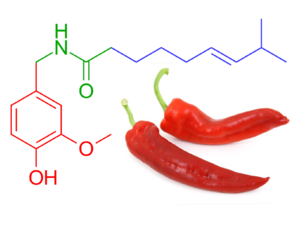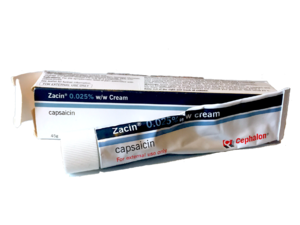Capsaicin

Capsaicin is an extract from the capsaicin plant and is available either with or without a prescription, depending on the strength and the form. Capsaicin is also known as cayenne, or red pepper, and is the substance that makes chili peppers hot.[1][2] It is typically used externally for painful conditions, including osteoarthritis, post-herpetic neuralgia and painful diabetic neuropathy. It is sometimes used for muscle or joint pain. Capsaicin is available in different strengths, either as a topical treatment (cream) or a transdermal patch.[2] Eating capsaicin in chili peppers produces a euphoria in some people as a response to the heat.
Theory[edit | edit source]
Evidence[edit | edit source]
Clinicians[edit | edit source]
Risks and side effects[edit | edit source]

Topical cream[edit | edit source]
Common and very common side effects:
- Transient burning
Rare:
- cough; eye irritation; sneezing
Other:
- dyspnea; exacerbation of asthma
Transdermal patches[edit | edit source]
Common and very common side effects:
- Transient burning; application site reactions; erythema; pruritus
Uncommon:
- burning sensation; cough; dysgeusia; eye irritation; first degree AV block; hypertension; hypoaesthesia; muscle spasm; nausea; pain in extremities; palpitations; peripheral edema; pruritus; tachycardia; throat irritation [2]
Risks[edit | edit source]
Capsaicin has a moderate risk of interactions with other medications, and may interact with herbal or natural remedies.[1]
Transdermal patches must be handled with nitrile gloves; latex gloves do not provide enough protection. Hands must be washed immediately after use, or within 30 mins if applying topical Capsaicin to hands.[2] There have been a number of cases of burns caused by Capsaicin.[3] It may also lower blood sugar.[1]
Costs and availability[edit | edit source]
Capsaicin is available in different strengths and forms, with some available over-the-counter and others only available on prescription. Brand names include Zacin (0.025% cream), Axsain, and Qutenza (8% transdermal).[1][2]
Learn more[edit | edit source]
- Medline
- BNF drug guide, in use in the NHS.
- FDA Consumer Updates
See also[edit | edit source]
References[edit | edit source]
- ↑ 1.0 1.1 1.2 1.3 "Capsicum: MedlinePlus Supplements". medlineplus.gov. Retrieved September 30, 2018.
- ↑ 2.0 2.1 2.2 2.3 2.4 Joint Formulary Committee. "Capsaicin". British National Foundry. London: BMJ Group and Pharmaceutical Press. Retrieved September 30, 2018.
- ↑ Office of the Commissioner, FDA. "Consumer Updates - Topical Pain Relievers May Cause Burns". fda.gov. Retrieved September 30, 2018.

